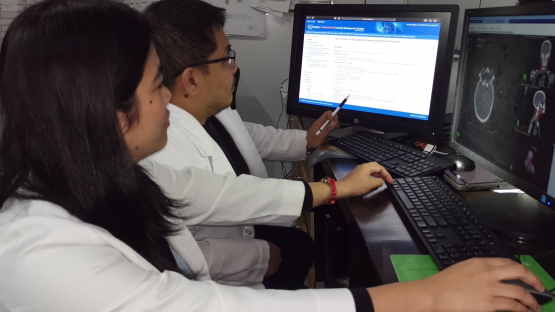There is a shortage of medical physicists in Asia and the Pacific, yet demand for their crucial expertise is growing; these specialists play an important role in the safe and effective use of radiation for diagnosing and treating health conditions such as cancer and cardiovascular diseases. In efforts to fill this expertise gap, several countries in the region are now using an online tool called AMPLE, or the Advanced Medical Physics Learning Environment. This IAEA-developed environment provides budding medical physicists with guided learning materials and remote mentorships to enhance their clinical training in hospitals.
“The AMPLE initiative is helping us enhance the recognition, registration and continuous professional development of medical physicists at the national level. Thanks in part to this work, we have witnessed a rapid increase in the number of practitioners in the field,” said Supriyanto Ardjo Pawiro, a senior lecturer in the Department of Physics, Faculty of Mathematics and Natural Sciences at the University of Indonesia and the national programme coordinator for AMPLE in Indonesia. Between 2015 and 2018, the number of trained medical physicists in Indonesia increased from 14 to 61, which was in part due to the country’s growing emphasis on medical physics education, including tools like AMPLE.
Working in teams alongside oncologists and other healthcare professionals, clinical medical physicists’ duties include, among others, planning and verifying that safe and effective radiotherapy is delivered for treating cancer and ensuring diagnostic imaging provides optimal results with minimal radiation exposure to the patient. Their work requires a postgraduate-level degree in medical physics, a comprehensive understanding of both medicine and physics and years of extensive clinical training.
AMPLE is designed to support this rigorous preparation of clinically qualified medical physicists in Asia and the Pacific by providing a structured, instructor-led learning environment focused on key competencies in areas such as nuclear medicine, diagnostic radiology and radiotherapy. This easy-to-use online tool also connects trainees with experienced professionals in centres around the region, which helps them to strengthen their knowledge, particularly in preparing to meet national requirements for practicing as a medical professional.
Over 200 junior clinical medical physicists and 300 supervisors and content developers are now using AMPLE. Since AMPLE was first launched in 2014, it has been used by hundreds of medical physicist residents in Bangladesh, Bhutan, Cambodia, India, Indonesia, Malaysia, Myanmar, Nepal, the Philippines, Singapore, Thailand and Viet Nam.
“AMPLE is now widely used around the region. As a web-based tool, it offers a unique support to structured and locally supervised clinical training,” said Giorgia Loreti, a training officer in the IAEA’s Division of Human Health. “To help countries continue to benefit from AMPLE, we plan to keep supporting updates and expansion of the resources and reference materials for each submodule. We would also like to see the AMPLE model adopted by other regions so that we can establish a vibrant, international network through which medical physicists can connect and learn from each other.”
AMPLE was developed through the IAEA regional technical cooperation project ‘Strengthening the effectiveness and extent of medical physics education and training’. It is available through the IAEA’s Cyber Learning Platform for Network Education and Training (CLP4NET).






